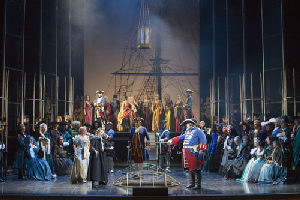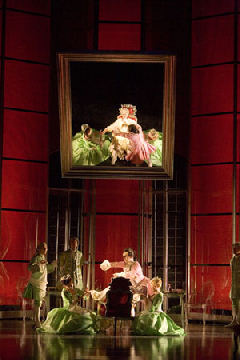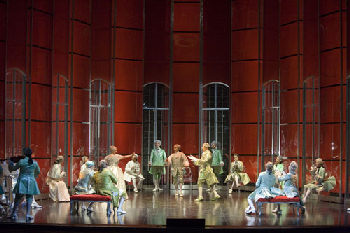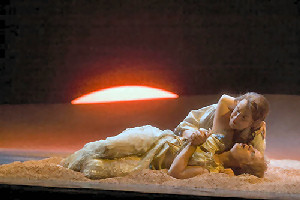|
Editor:
Marc Bridle
Webmaster: Len Mullenger
|
Seen and Heard International
Opera Review
Puccini, Manon Lescaut: (new production) at the
Royal Opera Stockholm 10.12.2005
(GF) Sets: Lars Östbergh Costumes: Annsofi Nyberg Lighting: Hans-Åke Sjöquist Choreography: Carina Jarlemark Director: Knut
Hendriksen Conductor: Roland Böer Cast: Manon Lescaut: Sara Olsson
(soprano) Lescaut: Anders Larsson (baritone) Chevalier Des Grieux: Lars Cleveman (tenor) Geronte de Ravoir: Sten Wahlund (bass) Edmondo: Ulrik
Qvale (tenor) An innkeeper: Per-Arne Wahlgren
(baritone) A singer: Susann Végh (mezzo-soprano) A dancing master: Ulrik Qvale (tenor) A lamplighter: Niklas Björling Rygert (tenor) A sergeant: Björn Blomqvist
(bass) A captain in the Navy: Per-Arne Wahlgren
(baritone)
This is only the second production of Manon Lescaut
ever at the Stockholm opera, the first mounted on November
22nd 1929 and running until 1960, so it is
45 years since it was last seen. Incidentally the young
Jussi Björling
made his first appearance on the stage in the small role
as the lamplighter in the third act in September 1930
and his penultimate performance in Stockholm was as Des
Grieux in November 1959. It
is interesting to note that another Björling,
although not related to Jussi,
sings the lamplighter in the new production.
Roland Böer’s conducting could
be characterized as vital, even forceful, which seems
like a strange thing in Puccini, where subtlety normally
is the order of the day, but Böer obviously sees a parallel with Tosca and even though this is no “shabby little shocker” it is indeed
just as cruel. With fastish
speeds he really kept things going and avoided sentimentality.
The first act soothed with life and movement, the over-long
second act felt surprisingly short and in the crowded
third act he propelled the action relentlessly forward.
And why not? The young Toscanini, who was no slowcoach, conducted
the work in Pisa, just a year after its first performance,
having had busy correspondence with the composer, who
many years later wrote appreciatively about Toscanini’s
ability to “bring life to my music with incomparable poetry,
flexibility and impassioned temperament”. While not perhaps
being a new Toscanini, Roland Böer
definitely made the music come alive, abetted of course
by the orchestra who have been in glorious shape lately.Of the singers Sara Olsson in the title role was excellent
with much impassioned singing, not least in the last act.
Her bright soprano shone effortlessly over the orchestra
and she made a convincing portrait of the young girl:
shy in the beginning, haughty in the second act and tragic
in the remaining acts. The duets with Lars Cleveman
were maybe the highlights of the performance. Cleveman
is no newcomer to his role, he sang Des Grieux
in Copenhagen a couple of years ago, and as always his
was a deeply intense interpretation. Once or twice he
was a notch overemphatic but otherwise this was a consummate
reading of the part. He has a glorious voice with an Italianate
timbre and lovers of full throated tenor singing got their
full share in his set pieces. He is small of stature but
his voice is anything but small – but
make no mistake, this was no can belto singing,
Cleveman can also express the
finest nuances in a lovely half voice. Readers should
be aware of that he also sings Don Carlo in the complete
Naxos recording made some five years ago. He was even
better as Des Grieux! Italianate in timbre was also Anders
Larsson’s Lescaut. In the first act his lowest notes seemed weak,
but in the second he had no problems carrying them out.
It was not a very subtle portrait though, emphasising
the brutal side of the character. Trond Halstein Moe in the Oslo production
made Lescaut a much nobler person.
Veteran Sten Wahlund has retained
most of his impressive bass voice and drew a sharply profiled
portrait of Geronte, authoritative
and frightening. In the lesser roles Ulrik
Qvale was a good Edmondo
and Susann Végh’s
creamy mezzo-soprano was an asset as the singer in act
two, while Björn Blomqvist’s demonstrated his thunderous bass voice as the
sergeant in the Le Havre act. Göran Forsling Photographs
© Bengt Wanselius |
| ||
|
||||






